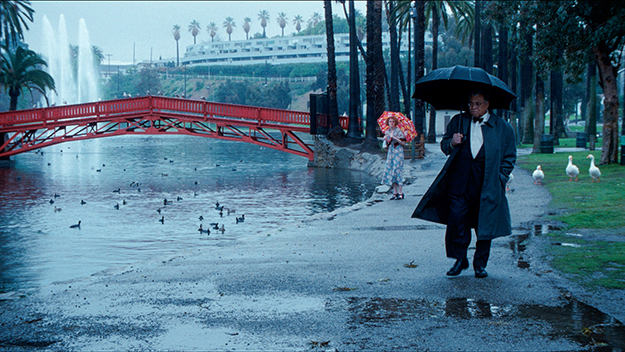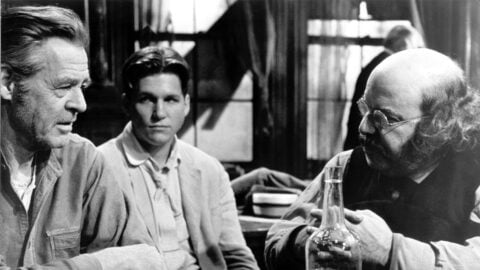Love and Its Peculiar Habits
This article appeared in the April 5, 2024 edition of The Film Comment Letter, our free weekly newsletter featuring original film criticism and writing. Sign up for the Letter here.

The Annihilation of Fish (Charles Burnett, 1999)
In an amusing early scene in Charles Burnett’s 1999 The Annihilation of Fish, which is only now reaching audiences after decades without distribution, boardinghouse manager Mrs. Muldroone (Margot Kidder) asks a prospective tenant (Lynn Redgrave), “Do you have any insidious vices that I should know about? No peculiar habits?” As the viewer will come to realize over the course of this sweet romantic comedy, it is the latter half of Mrs. Muldroone’s query that drives the story and provides the film with its appeal and warmth. Indeed, the particular charm of Burnett’s long-delayed release is its willingness to explore the themes of human identity and connection through this lens of “peculiar habits.” Perhaps, in some way, that focus explains the lack of industry attention the film has received in the past quarter-century.
The Annihilation of Fish tells the story of a romance between two aged and eccentric characters. The elegant Obadiah “Fish” Johnson (James Earl Jones) has moved to Los Angeles following his release from a psychiatric institution, the main symptom of his mental instability being that he routinely wrestles with an invisible demon named Hank. Soon after his arrival, Poinsettia (Redgrave) moves into the apartment across the hall, fresh from her breakup with her unseen (and long-dead) lover, opera composer Giacomo Puccini. Over the course of the film, the pair of outsiders grow closer over shared meals and outings, overseen and supported by their landlady, the kind and equally quirky Mrs. Muldroone.
The characters’ idiosyncrasies are not simply played for comic relief. The Annihilation of Fish has a tonal and emotional lightness that serves as a baseline from which moments of humor as well as pathos emerge. I laughed out loud at Fish’s observation that all of his friends were “dead or bowling in a league,” and at Poinsettia’s response to Fish’s concerns about their differences: “Old is what we have in common!” Lines like these are genuinely funny, and they also underscore the melancholy feeling of time slipping away from people who still want so much more from life. Fish insists on treating its characters and their strange behaviors in an earnest manner, and indeed, they barely bat an eye at each other’s oddities. In this regard, Fish reminds me a bit of Jean-Pierre Jeunet’s fanciful 2001 comedy Amélie (filmed after but released prior)—but where Amélie rendered its setting, Montmartre, as bright and hyperreal, an animation come to life, Fish captures the Echo Park neighborhood of Los Angeles with grounded realism, undergirding the eccentricity on display with a sense of sincerity rather than whimsy.
The film presents its characters’ delusions not simply as sad indicators of mental decline, but instead as elements that comprise the totality of their being. Fish’s struggles with Hank shape his identity as much as his Jamaican roots do. Poinsettia’s passion for life manifests itself in her fiery relationship with Puccini as well as in her occasional overindulgence in alcohol. Our selves, the film suggests, are comprised of things both big and small, of parts both commonly shared and specific to individual psyches. At its core, The Annihilation of Fish is a film about how people give shape and meaning to their lives when the conventional forms of socialization—namely, marriage and family—either cease to be present for them or, perhaps, never were.
When The Annihilation of Fish—with its meditation on love, companionship, and community—is placed within the context of Burnett’s larger oeuvre, clear thematic and stylistic through lines emerge. Like in his other work, Burnett stages the home as the site where social and cultural issues converge with the interpersonal. In Fish, the boardinghouse serves as the space where individuals negotiate aging and its effects on their senses of self and community, just as the family home stood as a battleground for generational and geographic conflicts in To Sleep With Anger (1990). Burnett’s ability to articulate the layered and complex emotional interiority of his characters in the smallest and most elegant of ways imbues seemingly slight gestures with intense meaning. In Fish, a scene of Poinsettia applying her makeup echoes a moment from The Wedding (1998) where a bride contemplates the reality of her union as she regards herself in the mirror. Poinsettia’s trembling hand as she holds her eyelash curler, conveying the depth of her emotions, also recalls a moment in Killer of Sheep (1978) when a husband lightly touches his wife’s knee with his finger, a minor act that feels electric after the film has painstakingly chronicled the emotional distance between the pair.
Given Burnett’s inarguable status as a visionary filmmaker, his pioneering work in the L.A. Rebellion film movement, and his MacArthur “genius” award, it is frustrating that it took 25 years for the film to reach the public. The Annihilation of Fish premiered at the 1999 Toronto International Film Festival to a positive response, and yet, the story goes, a single bad review of the film by Variety critic Todd McCarthy was enough to scare away potential distributors. More likely the review, which ran less than 500 words, confirmed the unfounded biases that distributors probably already had about the film, being unable to envision the commercial viability of an interracial love story that does not make race and age “problems” to be solved, but rather treats them as mere facts of existence.
Whereas McCarthy pejoratively described Fish as “a minnow of a movie” about “oldsters,” his criticism highlights the very aspects that make the film unique and noteworthy, and the ways in which Burnett’s approach to storytelling reflects the hurdles that filmmakers like him face, both then and now. Burnett’s Killer of Sheep and My Brother’s Wedding (1983) also received distribution only decades after their premieres. These are all part of a larger history of “lost” films by or centering African Americans that have only recently attracted public attention, including Something Good – Negro Kiss (William Selig, 1898), Lime Kiln Club Field Day (T. Hayes Hunter and Edwin Middleton, 1913), Cane River (Horace B. Jenkins, 1982), and Losing Ground (Kathleen Collins, 1982). It is worth reflecting on the significance of this consistent pattern for Burnett and other filmmakers, who work without large studio support, and who privilege the beauty and the depth of the everyday over grandiose narratives.
A story about older people finding love is already something novel in our youth-obsessed culture, but The Annihilation of Fish does something more: it emphasizes how care means respecting the things that people hold dear even when they themselves cannot fully comprehend such things. Love can mean believing the other person’s fictions. Our “peculiar habits,” the film implies, are among the myriad things that make us human, and accepting them in one another is the basis for love in all forms.
Racquel Gates is an associate professor of film at Columbia University, and the author of Double Negative: The Black Image and Popular Culture (Duke University Press, 2018).







